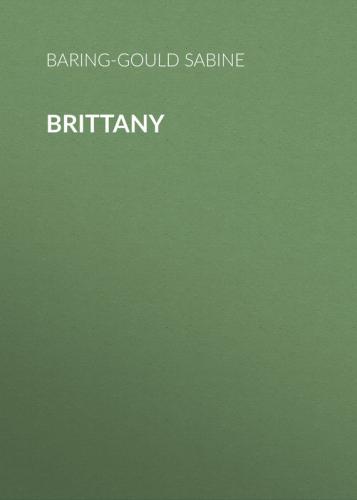Each sheet costs about 25 centimes or 2½d. The same can be had in colours at 1 franc per sheet, but there is no great advantage in these latter.
In this book routes have not been given, as there is such a diversity of manner of travelling in these days, some going by train, and some by bicycle and motor car. For the latter the best map is that published by the cycling club, as it gives the roads that are suitable, and the hills are all indicated. The line adopted in this book has been to give the chefs-lieux d'arrondissement, and a few other places that are suitable as centres, and to indicate what is to be seen within an easy range all round.
Less details have been given relative to the Department of Ille-et-Vilaine, at least as to certain portions of it which do not offer much of interest to encourage a visit, and with regard to Loire Inférieure only the truly Breton region of Guérande and S. Nazaire has been included.
The following list of headquarters is recommended, whence excursions may be made radiating on all sides. Places of little moment and regions that need not occupy a visitor's time are omitted.
Côtes-du-Nord.– Dinan. Thence Lamballe, Plancoet, Ploubalay, Dol, Jugon, Becherel.
Guingamp. Thence Belle-Ile, Pontrieux, Plouagat, Bourbriac.
Lannion. Thence Perros-Guirec, Plestin.
Loudéac. Thence Uzel, Plouguenast, La Chèze, Mur.
Paimpol. Thence Lézardrieux, Pontrieux, Plouha and Iles de Bréhat.
Plouaret. Thence Plestin, Begard and Belle-Ile.
Rostrenen. Thence S. Nicolas du Pélem, Maël Carhaix, Goarec.
S. Brieuc. Thence Etables, Châtelaudren, Quintin, Lamballe.
Tréguier. Thence Lézardrieux, La Roche-Derrien.
Finistère.– Audierne. The Cap Sizun.
Brest. Thence S. Rénan, Ploudalmezeau, Lannilis, Plabennec, and Ouessant.
Châteaulin. Thence Crozon, Le Faou, Pleyben.
Châteauneuf-le-Faou. Thence Pleyben and Montagnes Noires.
Huelgoët. The Montagnes d'Arrée.
Landerneau. Thence Daoulas, Ploudiry, Sizun, and the Montagnes d'Arrée.
Landivisiau. Thence S. Thégonnec, Plouzévédé, Ploudiry and Sizun.
Lesneven, the coast by Plounéour-trez.
Morlaix. Thence Lanmeur, Taulé, Plouigneau, S. Thégonnec.
Pont-aven. Concarneau, Fouesnant.
Pont l'Abbé, the Penmarch peninsula.
Ploudalmezeau, Lannilis, and the coast.
S. Pol-de-Léon. Plouescat and the Ile-de-Batz.
Quimper may be made a centre for much, owing to several lines of railway diverging from it. Briec, Rosporden, Douarnenez, Pont Croix, Plougastel S. Germain, Pont l'Abbé.
Quimperlé. Thence Bannalec, Pont-aven, Pont Scorff.
Morbihan.– Auray. Thence Pluvigner, Belz, Carnac, Quiberon.
Baud. Thence Pluvigner, Locminé and the Blavet River.
Grand-Champ. Thence the Landes de Lanvaux, and S. Jean de Brévelez.
Hennebont. Thence Pont Scorff, Plonay, Lorient, Port Louis.
La Faouët. Thence Gourin and Guéméné.
Ploermel. Thence Josselin, Mauron, Guer, La Trinité-Porhoet.
Pontivy. Thence Cleguerec, Guéméné, the Blavet valley, Mur, Rohan.
Rochefort-en-Terre. Thence Elven, and the Lande de Lanvaux, Malestroit, la Gacelly, Questembert.
Vannes. The Morbihan, and Sarzeau, Elven and Grand Champ.
Ille-et-Vilaine.– Becherel. Thence Tinténiac, Hédé.
Dinard. Thence S. Malo, Cancale, S. Servan, Châteauneuf, Dol.
Dol. Thence Combourg.
Fougères. Thence Louvigné, S. Briac-en-Congles, S. Aubin-du-Cormier.
Montfort. Thence S. Méen and Montauban.
Redon. Thence Allaire, la Gacilly, Pipriac, Fougeray, S. Nicolas.
Rennes. Thence Mordelles, Guichen, Château-Giron, Janzé.
Vitré Thence Châteaubourg and Argentré-du-Plessis.
Loire Inférieure.-Guérande. La Grande Brière and the Saltmarshes.
Le Croisic. Sea coast and Saltmarshes.
S. Nazaire, mouth of the Loire.
Argentré (I.V.) chl. arr. Vitré. In the neighbourhood are many small lakes, forming one of the arms of the Vilaine, one of the sources of which is in the forest of Pertré. The château de Plessis is of the 15th cent. and has been restored. In it is a portrait of Mme. de Sevigné by Mignard. The circular chapel is of the 17th cent.
At Primel is a chapel of the 15th cent. A calvary is in the parish churchyard.
At Etrelles the church is of the beginning of the 16th cent.
Arzano (F.) chl. arr. Quimperlé. An uninteresting place, but some pretty scenery on the Ellé and Isole. The neighbourhood is best visited from Quimperlé.
* AUDIERNE (F.) a com. of Pontcroix. A large fishing village, at the mouth of a tidal creek, into which flows the insignificant Goujen. The entrance to the harbour is dangerous. The river front of the village or town is occupied almost wholly by buvettes. Sardines are here tinned. The church, originally dedicated to S. Rumon, the same as S. Ronan, has been transferred to the patronage of S. Raymond Nonnatus. It is well-situated, and of renaissance period, but has preserved an earlier internal arcade. The south porch is of the usual 16th cent. type in Lower Brittany, but with renaissance details. Ships are carved over the church. The tower with gallery is mean. A curious recess with stoup outside the W. end, with broken circle above it. An old house in the street bears the date 1668. Audierne swarms with children who pester the visitor with begging. It is an unattractive place, but has good inns, and forms a centre for an interesting district. See also Pont Croix.
At Primelin is the Chapel of S. Tugean (a Saint Antianus) in a hamlet, surrounded with trees. It is a noble structure throughout, in the flamboyant style. A noble south porch with statues within of six apostles. The tower without spire is early flamboyant, and has a curious side turret with spire. The W. doorway is good with the four doctors of the church above it. The N. transept is double, divided by round pillars surmounted by Doric capitals. The carved wood roof of the chancel and N. transept deserve notice. Rich rococo altarpieces. Paintings (1705) about the baptistery. A good statue of S. Tugean
